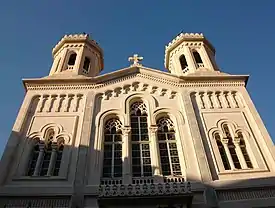Eparchy of Zahumlje and Herzegovina
The Eparchy of Zahumlje, Herzegovina and the Littoral (Serbian: Епархија Захумско-херцеговачка и Приморска) is an eparchy (diocese) of the Serbian Orthodox Church with its seat in Mostar, Bosnia and Herzegovina. It has jurisdiction over the region of Herzegovina, the littoral region of southern Dalmatia in Croatia and a small part of Montenegro.[3] Since 2018, the bishop of Zahumlje and Herzegovina has been Dimitrije Rađenović.
Eparchy of Zahumlje and Herzegovina | |
|---|---|
 Cathedral of the Holy Trinity, Mostar | |
| Location | |
| Territory | Parts of Bosnia and Herzegovina, Croatia and Montenegro |
| Headquarters | Mostar, Bosnia and Herzegovina[1][2] |
| Information | |
| Sui iuris church | Serbian Orthodox Church (Eastern Orthodox) |
| Established | 1219 (as Eparchy of Hum) |
| Cathedral | Cathedral of the Holy Trinity, Mostar |
| Language | Church Slavonic and Serbian |
| Current leadership | |
| Bishop | Dimitrije (Rađenović) |
| Map | |
-en.svg.png.webp) | |
| Website | |
| Eparchy of Zahumlje and Herzegovina | |
History
Ecclesiastical background
The region was under the Eastern Orthodox Metropolitanate of Dyrrachium, which in turn was under the Ecumenical Patriarchate of Constantinople. In 1089, the see of Trebinje (Travunia) was briefly theoretically under the jurisdiction of the Archbishopric of Bar.
Middle Ages
The Eparchy of Hum or Zahumlje was founded in 1219, by the first Serbian Archbishop Sava, the same year the Serbian Orthodox Church acquired its autocephaly status from the Patriarchate of Constantinople. Thus, it was one of the original Serbian Orthodox bishoprics. It had jurisdiction over the historical regions of Zahumlje and Travunija. The first Bishop of Hum was Ilarion, succeeded by Sava II (son of Stefan the First-Crowned). The original seat was in Ston, in the church of the Most Holy Theotokos (Пресвете Богородице). Following an earthquake, the bishop moved the seat to the Monastery of Holy Apostles in the valley of river Lim in the 1250s. From that time, the Eparchy of Hum was sometimes also called "Eparchy of Lim".
With the War of Hum (1326–1329), most of Zahumlje was taken over by Stephen II, Ban of Bosnia, but the Travunija region remained under the rule of Serbian Kings. After the creation of the Serbian Patriarchate of Peć in 1346, all original Serbian bishops were raised to the honorary rank of metropolitan bishops. Pope Clement VI in 1335 addresses to King Stefan Dušan and request him to stop the persecution and that to the bishop of Kotor which is responsible for Roman Catholic Diocese of Trebinje return monasteries, churches, islands and villages, which some kings of Raška before him overtook.[4] The see of the eparchy was then moved to the Mileševa monastery. In the middle of 15th century, Metropolitan David was a very influential figure in the court of Stefan Kosača, who was titled Duke (Herzeg) of Saint Sava. Following the fall of the Duchy of St. Sava to the Ottoman Empire (1482), the see was frequently moved, finally to settle in the Tvrdoš Monastery near Trebinje in 1508. Eventually, the eparchy was further divided into the Eparchy of Mileševa.
Modern and contemporary history
In 1557, Serbian Patriarchate of Peć was restored and the Eparchy of Herzegovina was returned to its jurisdiction, with its bishops of holding the honorary title of metropolitan.[5] In 1766, when the Serbian Patriarchate of Peć was abolished, Eparchy of Herzegovina and all other Serbian eparchies under Ottoman rule came under the jurisdiction of Ecumenical Patriarchate of Constantinople. Bishops of Herzegovina kept their honorary title of Metropolitan, as was also the custom in the Ecumenical Patriarchate.
The seat of metropolitan was transferred to Mostar. Since 1878, territory of Bosnia and Herzegovina was under the occupation of Austria-Hungary, but under the Church Convention of 1880 all Eastern Orthodox eparchies remained under the ecclesiastical jurisdiction of the Ecumenical Patriarchate of Constantinople. At the end of the First World War in 1918, Eastern Orthodox bishops in Bosnia and Herzegovina reached a unanimous decision to enter the united Serbian Orthodox Church. The process of unification was completed in 1920 and since then the Eparchy of Zahumlje and Herzegovina has remained part of Serbian Orthodox Church.[6] The seat of the eparchy was the Cathedral of the Holy Trinity, Mostar. As of 2017, it is being rebuilt after being demolished during the Bosnian War (1992-1995).
Heads
- Ilarion (13th century)
- Metodije (13th century)
- Teodosije (13th century)
- Nikola (13th century)
- Sava (until 1264)
- Jevstatije (ca. 1305)
- Jovan I (ca. 1316)
- Danilo (1316—1324)
- Stefan I (1324)
- Mileševa (ca. 1377)
- David (ca. 1465)
- Jovan II (1508—1513)
- Visarion I (1509—1525)
- Maksim I (before 1532)
- Marko (1531—1534)
- Nikanor (1534—1546)
- Antonije (1570—1573)
- Savatije I (1573—1585)
- Visarion II (1590—1602)
- Silvestar (1602—1611)
- Simeon I (1613—1635)
- Savatije II (1635—1642)
- Maksim II (1643—1648)
- Pajsije (1648—1651)
- Arsenije I (1651)
- Vasilije (1651—1671)
- Simeon II (1671—1681)
- Savatije III (1681—1693)
- Nektarije (1693—1712)
- Melentije (1712—1713)
- Arsenije II (1715)
- Gerasim (1715—1727)
- Aksentije I (1727—1736)
- Filotej (1741—1741)
- Aksentije II (1751—1760)
- Stefan II (1763—1766)
- Antim (1766—1772)
- Likanije (1772—1802)
- Jeremija (1803—1815)
- Josif I (1816—1835)
- Prokopije I (1838—1848)
- Josif II (1848—1854)
- Grigorije I (1855—1860)
- Joanikije (1860—1864)
- Prokopije II (1864—1875)
- Ignjatije (1875—1888)
- Leontije (1888)
- Serafim (1889—1903)
- Petar (1903—1920)
- Jovan III (1926—1931)
- Simeon (1932—1934)
- Tihon (1934—1939)
- Nikolaj (1939—1943)
- Longin (1951—1955)
- Vladislav (1955—1991)
- Atanasije (1992—1997)
- Grigorije II (1997—2018)
- Dimitrije (2018—)
Monasteries
There are eight monasteries in the diocese:
- Dobrićevo
- Duži
- Žitomislić
- Zavala
- Zubci
- Petropavlov
- Tvrdoš
- Hercegovačka Gračanica
See also
- Eastern Orthodoxy in Bosnia and Herzegovina
- Serbs of Bosnia and Herzegovina
- List of the Eparchies of the Serbian Orthodox Church
- Cathedral of the Holy Trinity, Mostar
- Holy Annunciation Orthodox church, Dubrovnik
References
- Blic online: Posle 18 godina Mostar ponovo sedište zahumske eparhije ("Mostar seat of the Diocese of Zahumlje again after 18 years"), 02 Jan 2011 (in Serbian)
- Vesti online: Eparhija zahumsko-hercegovačka posle 20 godina u Mostaru ("Eparchy of Zahumlje and Herzegovina in Mostar after 20 years"), 31 Dec 2010 (in Serbian)
- Official SPC site: Eparchies Links (in Serbian)
- Dijana Pinjuh, VJERSKE PRILIKE KOD KATOLIKA U HERCEGOVINI (OD TURSKOG OSVAJANJA DO KONCA 17. STOLJEĆA,Zagreb, 2013. https://repozitorij.hrstud.unizg.hr/islandora/object/hrstud:1512/preview #page= 15
- Sotirović 2011, pp. 143–169.
- Kiminas 2009, pp. 22, 28.
Sources
- Јанковић, Марија (1985). Епископије и митрополије Српске цркве у средњем веку (Bishoprics and Metropolitanates of Serbian Church in Middle Ages). Београд: Историјски институт САНУ.
- Boris Nilević (1990). Srpska pravoslavna crkva u Bosni i Hercegovini do obnove Pećke patrijaršije 1557. godine. Veselin Masleša.
- Вуковић, Сава (1996). Српски јерарси од деветог до двадесетог века (Serbian Hierarchs from the 9th to the 20th Century). Евро, Унирекс, Каленић.
- Bataković, Dušan T. (1996). The Serbs of Bosnia & Herzegovina: History and Politics. Dialogue Association. ISBN 9782911527104.
- Mileusnić, Slobodan (1997). Spiritual Genocide: A survey of destroyed, damaged and desecrated churches, monasteries and other church buildings during the war 1991–1995 (1997). Belgrade: Museum of the Serbian Orthodox Church.
- Radić, Radmila (1998). "Serbian Orthodox Church and the War in Bosnia and Herzegovina". Religion and the War in Bosnia. Atlanta: Scholars Press. pp. 160–182. ISBN 9780788504280.
- Popović, Svetlana (2002). "The Serbian Episcopal sees in the thirteenth century (Српска епископска седишта у XIII веку)". Старинар (51: 2001): 171–184.
- Ćirković, Sima (2004). The Serbs. Malden: Blackwell Publishing. ISBN 9781405142915.
- Kiminas, Demetrius (2009). The Ecumenical Patriarchate: A History of Its Metropolitanates with Annotated Hierarch Catalogs. Wildside Press LLC. ISBN 9781434458766.
- Sotirović, Vladislav B. (2011). "The Serbian Patriarchate of Peć in the Ottoman Empire: The First Phase (1557–94)". Serbian Studies: Journal of the North American Society for Serbian Studies. 25 (2): 143–169. doi:10.1353/ser.2011.0038.
External links
- Eparchy of Zahumlje and Herzegovina (in Serbian)


